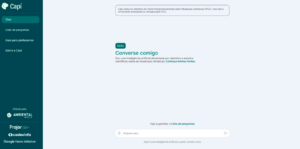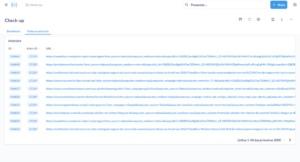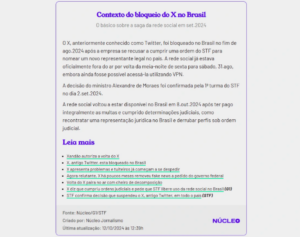Brazil’s Institute for the Development of Journalism, or Projor for its initials in Portuguese, launched the second phase of the Innovation Fund to Combat Disinformation (Codesinfo), focused on the dissemination of five open-source digital tools created to strengthen the fight against online disinformation. Developed by Brazilian media outlets in late 2024, the solutions are available free of charge to any journalistic organization inside and outside Brazil.
To reach international media outlets, Francisco Belda, Projor's director of operations and coordinator of Codesinfo, said that the Codesinfo website is being translated into English and Spanish and the partner media outlets that created the tools are receiving support for networking activities to publicize the solutions.
"We believe that the five tools strengthen civic journalism in general," Belda told LatAm Journalism Review (LJR). "This is due to their role in valuing the concept of authorship (Quem Disse? tool), fact-checking (Check-up), scientific evidence in environmental and climate change coverage (Capí chatbot), production of short videos based on textual reports (Mosaico) and in the provision of updated contextual information (Xarta)."

Capí fights environmental and climate disinformation through an AI-powered chatbot (Disclosure/Codesinfo)
Capí is an artificial intelligence chatbot developed by Ambiental Media that was launched in beta version in November 2024. The tool's purpose is to provide clear, up-to-date and reliable answers to users' questions on climate issues.
“I had the idea of creating a climate chatbot precisely because I realize it is a subject that, no matter how hard we try, still raises a lot of questions. I think the scientific community has a hard time communicating data clearly,” Thiago Medaglia, executive director of Ambiental Media, told LJR. “And it’s not just about clarity, right? Ambiental Media’s premise is for science to be transformed into accessible, clear and attractive journalistic content.”
Developed by a multidisciplinary team of engineers, journalists, educators and designers, Capí uses a restricted database that includes reports from Ambiental Media and documents from renowned scientific organizations. Its main sources include reports from the Intergovernmental Panel on Climate Change (IPCC), a UN body that evaluates scientific data on global warming, its impacts and mitigation strategies.
“We believe that Capí can provide support in the production of a story, or in the review stage of a report, or in the search for sources or themes. For example: you are working on a call for proposals and want to expand, do a brainstorming session. Capí can help with all of this. In checking information as well,” Medaglia said.

Screenshot of the Capí chatbot interface (Disclosure)
The technology behind Capí is Gemini, the large language model (or LLM) developed by Google. To efficiently produce reliable answers, the tool uses retrieval-augmented generation (RAG), a technique proposed in 2020 to, among other things, reduce hallucinations and contextualize LLMs according to specific uses.
Capí does not collect personal data from users, but uses the content of interactions for continuous learning through a technique known as prompt tuning. The chatbot's infrastructure operates on special Google Cloud servers, optimized for reduced energy consumption and low carbon dioxide emissions, in line with the tool's environmental goals.
“Capí is a beta AI, so she can certainly hallucinate and make mistakes. We describe this on the website. Errors are reported and we correct them, but she uses reliable sources that we have selected very carefully and with great discretion.”
The tool's Github page can be accessed here, as well as the project history and system architecture.

The Check-up project, developed by Aos Fatos, is an initiative aimed at analyzing the presence of disinformation in health-related ads on major Brazilian news websites. (Disclosure/Codesinfo)
Another tool developed within Codesinfo is Check-up, a solution created by fact-checking site Aos Fatos to analyze health advertisements on major Brazilian news sites that may contain misleading information.
“The project arose from a concern about the lack of moderation on native advertising platforms used by major news sites. These tools take advantage of the credibility of journalism to make money from disinformation — and they do so with the consent of media companies,” Bruno Fávero, innovation director at Aos Fatos, told LJR. “We saw that ads with disinformation were common, but there was no data to analyze the problem systematically and rigorously. We created Check-up so that our newsroom, as well as other researchers and journalists, could study the subject.”
The process of collecting and analyzing ads uses a combination of automation and manual analysis. The Aos Fatos team created scrapers that visit major portals every day and collect native ads. They then use a language model to classify each ad by theme. Finally, reporters analyze the ads using Aos Fatos' fact-checking methodology, which is public. Verifiable statements are compared with primary sources, public data, reliable studies or consultations with experts and are then given a rating.

Screenshot of a list of ads gathered by the tool. (Disclosure/Codesinfo)
The tool's code is open and published on Aos Fatos' GitHub and can be used by researchers and journalists interested in the topic. The tool's documentation explains how to adapt the code to collect ads from other websites.
“News organizations that use native ad services can also use Check-up to analyze the quality of the ads they run and pressure the platforms to improve moderation,” Fávero said. “The challenge of financing journalism in Brazil is extremely difficult, but the answer cannot be a practice that goes directly against the profession’s reason for existing.”
Mosaico is a Python library created by major newspaper Folha de S.Paulo to convert text into short videos using artificial intelligence. Built on MoviePy, one of the most popular video editing libraries in Python, Mosaico offers an interface for working with media assets, positioning elements, applying effects and generating video scripts.
“The newspaper chose this solution to face the growing challenge of misinformation, in a scenario where the consumption of short videos is increasing significantly,” Daniela Braga, Folha’s Artificial Intelligence editor, told LJR. “By transforming text content into short videos, using artificial intelligence, Folha is able to offer a different type of narrative that, based on original content, can impact audiences who prefer videos to texts, thus expanding the reach of its news.”

Mosaico is a Python library created by Folha de S.Paulo and designed to programmatically create and manage video compositions. (Disclosure/Codesinfo)
According to Braga, the difference between Mosaico and other automated video solutions is that it is a proprietary tool, maintained in-house, trained based on Folha's own content and developed to meet the newspaper's journalistic quality parameters and standards.
"The creation of videos is supervised by Folha journalists, who review and approve the final result. Text and images are real. More video reports have been published, however, their use has recently begun to expand,” Braga said.
For other media outlets that want to adopt the tool, Braga said that with the repository available on GitHub it is possible to customize the tool to meet specific needs. According to her, because it is open source software, developers and journalists can contribute with improvements, corrections and new features.
“This way, the community itself can drive the evolution of the tool,” Braga said. “This automation also speeds up video production to meet the demand for short, dynamic content on social media and to reduce the need for dedicated teams.”

“Quem Disse?” , which means “Who said it?” in Portuguese, is a plugin for the WordPress CMS created by Folha do Mate, a newspaper from Venâncio Aires, in the Brazilian state of Rio Grande do Sul. (Disclosure/Codesinfo)
The plugin "Quem Disse?" (Who said?), developed by Folha do Mate, a news outlet focused on community journalism operating in Rio Grande do Sul in southern Brazil, is a WordPress extension inspired by LinkedIn that makes it easier to build and standardize journalist profiles. The idea is to inform readers about professional traits of the writers, such as coverage areas and the reporter's experience. The plugin also includes a database of recurring sources, such as authorities and experts, providing mini-resumes for each one.
The plugin is a continuation of the outlet's previous initiatives aimed at combating misinformation, said Paula Carvalho, commercial director at Folha do Mate. Other initiatives include journalism workshops in schools, educational quizzes on the risks of misinformation and fact-checking of news sent by readers.
“The ‘Quem Disse?’ plugin was created with the aim of highlighting the authors of the articles, valuing the credibility of the source and bringing journalists and reporters even closer to readers, promoting more responsibility and clarity in the production of content,” Carvalho said.
With over 50 years in existence, Folha do Mate currently has, according to Carvalho, around 4,000 active subscribers.
“This demonstrates a solid and trusting relationship,” he said. “We believe that by being transparent about our processes, authorship and sources, we reinforce our commitment to serious journalism and the development of the region where we operate.”
The plugin was developed only for the WordPress platform and the installation instructions are on the Folha do Mate website and on Github.

Xarta is an open-source mini content management system (CMS) specifically designed to automate the updating of contextual content in various news reports. (Disclosure/Codesinfo)
Xarta is a system created by Núcleo Jornalismo that automates the process of giving context to articles through "embeddable" cards inserted into various news reports. Xarta also helps prevent decontextualized content from being used to misinform the population.
One example of Núcleo’s use of the tool happened during the blocking of social network X in Brazil in August 2024. Instead of creating and updating the context for each report on the subject, the team used Xarta to ensure that new texts had the most accurate and current background on the subject, and that even old articles were always up to date.
“Having ready-made context of news events we are following helps our work, facilitates agility in publishing new articles, and ensures that the context added will be the most complete and up-to-date. At the same time, we began to notice in our audience data that the latest report of a specific news event is not always the one with the most traffic. These articles, with old context, could then be used maliciously,” Jade Drummond, Núcleo’s operations director, told LJR. “The combination of these two findings was what gave rise to the project. We created a tool that keeps the texts updated for longer, provides better context for the news event and optimizes the newsroom’s work.”

Xarta card example about the Twitter blocking in Brazil. (Disclosure/Codesinfo)
Xarta eliminates the need to rewrite the context of the same topic several times and also prevents the reporter from having to manually go back to old articles to include important contextual information.
“Reporters and editors do not need specific technical knowledge to use Xarta on a daily basis. However, those who are going to create the Xarta application for the newsroom need technical knowledge to use our documentation and open source code, or they can hire Núcleo to create this application,” Drummond said. “Once the Xarta page for the newsroom is created, with the customizations they want and the standard visual identity model, it is very easy and intuitive to use.”
Drummond explained that each newsroom can create its own Xarta, but they can also use context cards from other media outlets that have been released for reproduction, such as some made available by Núcleo.
“We have some cards that are public and we allow reproduction via Creative Commons License 4.0, the person just needs to access the card and go to the page that contains the embed code, which they can copy and insert into their article,” Drummond said. “All newsrooms that create their own Xarta can decide whether or not they want to allow the reproduction of the context cards produced.”